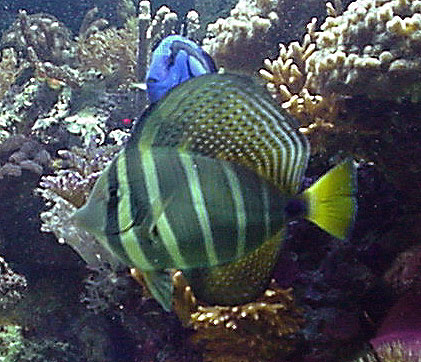Sparring Tangs (photo
taken 8/23/2000)
- Sailfin tang (Zebrasoma veliferum) with fins raised during a
threat display directed toward the blue tang (Paracanthus hepatus)
at feeding time. During such shows of aggression, tangs and other surgeonfish
species often swipe their tails at rivals with tail
spines erected.

Color change in sailfin tangs:
- In addtion to fin displays, sailfin tangs often undergo rapid color
changes reflecting changes in mood (e.g., coloration is often distinctly
different when sailfin tangs are at rest vs. frightened vs. showing aggression
toward rivals). Though the general pattern does not change, sometimes sailfin
tangs become extremely dark (with the light sripes barely visible), other
times the contrast between the yellow and brown stripes becomes very bold
and distinct, and other times the overall coloration becomes somewat pale
with the dark spot surrounding the tail spine very dark and distinct.
-
- Color change in other fish:
-
- Though not all fish species exhibit such dramatic color changes, color
change in fish is commonplace in both marine as well as freshwater fish
species, and often these color changes occur very rapidly (within seconds
or even faster):
- In some cases this color change occurs to better camoflauge the fish
as it moves to different colored backgrounds. Flounders are masters of
such color change, often even matching the patterns they are resting on,
but many other species of fish lighten or darken their overall coloration
in response to light vs. dark backgrounds, respectively.
- Aggressive interactions between fish and territorial displays are often
associated with color changes, and in some species dominant and subordinant
individuals can be distinguished based on their coloration.
- Many species of fish exhibit color changes when courting or spawning.
Sometimes these color changes last for the duration of the breeding season,
but often the breeding colors are rapidly turned on and off during the
course of interactions with mates.
- Many species of fish change color at night. In some cases individuals
don't even look like the same species at night!
- In addition to the rapid changes discussed above, many fish species
change color dramatically when they reach adulthood, and in some cases
males and females have very different coloration. This is particulary common
in some families of coral reef fishes. For some of these species coloration
can difer so greatly between age classes or genders that it took many years
after their discovery before biologists recognized that juveniles and adults
(or in some cases males and females) actually belonged to the same species!

